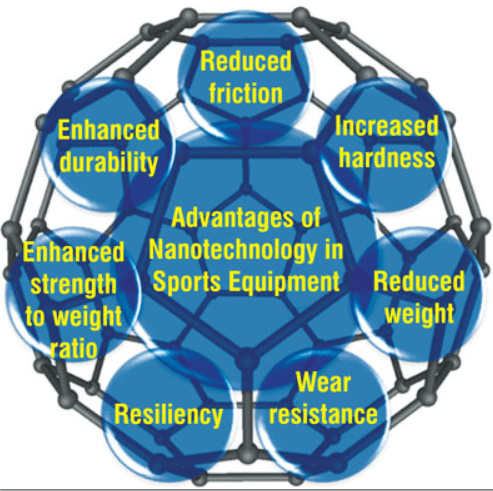Use of Nanomaterials in Sports Equipment
Nanomaterials have transformed the sports equipment industry by providing equipment with exceptional strength, durability, reduced weight, enhanced performance, vibration damping, and customization options.
Athletes can now enjoy gear that not only helps them perform better but also offers superior comfort and safety, contributing to a more enjoyable and successful sports experience. Elevate your game and achieve new heights in your sporting endeavors with us. Discover the unparalleled advantage of our innovative products today!
Introduction
The realm of sports equipment has undergone a significant transformation with the advent of nanotechnology. The incorporation of nanomaterials in sports gear has opened new avenues for enhanced performance, durability, and lightweight design. Nanomaterials, with their unique properties like increased strength, flexibility, and resistance to wear and tear, have revolutionized the way sports equipment is designed and manufactured. From tennis rackets and golf clubs to protective gear and athletic footwear, the application of nanotechnology has not only improved the functionality of sports equipment but also has contributed to the safety and comfort of athletes.
Basics of Nanomaterials
Nanomaterials, typically characterized by their dimensions falling within the nanoscale range of 1 to 100 nanometers, offer unique properties and behaviors owing to their size and high surface area-to-volume ratio. The nanomaterial family includes nanoparticles, nanotubes, nanofibers, and nanocomposites. These materials exhibit distinctive features, such as quantum effects and high surface areas, which can lead to variations in electronic, optical, and magnetic properties. The synthesis of nanomaterials can follow either a top-down approach, breaking down larger materials, or a bottom-up approach, building up materials from atomic or molecular components. Nanomaterials have wide-ranging applications, from enhancing electronics and catalysis to improving medicine and energy technologies. However, their use raises safety and environmental concerns, necessitating thorough research into potential toxicity and long-term effects, as regulatory bodies and institutions grapple with safety and ethical implications in the field of nanotechnology.
How Nanomaterials Enhance Sports Equipment?
Nanomaterials have revolutionized the sports equipment industry by enhancing the design and performance of various gear. One of the key advantages of nanomaterials in this context is their remarkable strength and durability. Carbon nanotubes and nanofibers, for instance, are integrated into sports equipment like tennis rackets, golf clubs, and bicycle frames to reinforce their structures, making them more resistant to breakage and damage during use. This results in equipment that can withstand the rigors of sports, ensuring athletes have gear they can rely on.
Another significant benefit of nanomaterials is their lightweight properties. By incorporating nanocomposites into sports equipment, manufacturers can reduce weight while maintaining or even improving strength. Lighter equipment is more comfortable for athletes to wield or wear, enhancing their agility and reducing fatigue during extended use. This weight reduction is especially critical in sports where quick movements and endurance are paramount.
Furthermore, nanomaterials offer the potential to enhance the overall performance of sports equipment. For example, tennis rackets with nanomaterial frames provide a blend of power and control that can significantly improve a player's game. Similarly, golf clubs with nanomaterial heads offer improved accuracy and distance, while bicycle frames reinforced with nanomaterials provide superior aerodynamics. Athletes benefit from equipment that empowers them to reach new levels of performance. In addition to strength, weight reduction, and performance enhancement, nanomaterials can be engineered to dampen vibrations and absorb shocks in sports equipment. This technology is particularly beneficial in tennis racket strings and bicycle frames, making the playing experience more comfortable, reducing the risk of injury, and allowing athletes to maintain better control over their gear. Nanomaterials also enable a level of customization in sports equipment that was previously unattainable. Manufacturers can engineer nanomaterials to possess specific properties tailored to the needs of individual athletes. This personalization ensures that athletes can enjoy equipment that aligns with their unique preferences and requirements.
Moreover, the integration of nanomaterials into sports equipment is done seamlessly, whether through coatings, composites, or structural reinforcements. This ensures that athletes can enjoy the benefits of nanomaterials without compromising the overall design and aesthetics of their gear. Lastly, nanomaterials are used in safety equipment, such as helmets and padding, to enhance impact resistance while maintaining comfort and fit. Athletes can enjoy improved protection without sacrificing mobility or comfort, ensuring their safety during play.

Figure 1. Nanotechnology advantages in sports equipment.
Applications of Nanomaterials in Different Sports
Nanomaterials have significantly advanced sports equipment in various sports:
Tennis and Golf: Nanomaterials in racket frames and clubheads improve strength and reduce weight, leading to better control and distance in shots.
Cycling: Nanomaterials in bike frames enhance strength and aerodynamics, making bikes more efficient.
Hockey: Sticks with nanomaterials offer improved power and precision, while protective gear enhances safety.
Swimming: Competitive swimwear uses nanomaterials to reduce water drag, leading to faster times.
Skiing and Snowboarding: Nanomaterial coatings on equipment improve performance and durability.
Athletic Footwear: Nanomaterials enhance cushioning, flexibility, and durability for better comfort and support.
Sports Balls: Nanomaterial coatings optimize aerodynamics, durability, and performance.
Safety Equipment: Helmets and protective gear incorporate nanomaterials for better impact resistance and safety.
These applications result in better performance, durability, and safety for athletes across a range of sports.
Comparing Traditional vs. Nano-Enhanced Equipment
Comparing traditional sports equipment with nano-enhanced gear reveals significant advantages in favor of nanomaterials. Traditional equipment, while durable to some extent, often lacks the robustness and wear resistance that nano-enhanced materials offer. Nano-enhanced equipment, thanks to materials like carbon nanotubes, is exceptionally strong and resilient, significantly reducing the risk of breakage and damage during intense sporting activities. Weight is another crucial factor. Traditional equipment can be heavy, potentially hampering an athlete's performance due to added weight. In contrast, nano-enhanced equipment is typically lighter, thanks to advanced materials, allowing athletes to move more efficiently and with reduced fatigue, contributing to enhanced agility and performance.
Performance is a key consideration in sports, and here too, nano-enhanced equipment shines. It offers superior performance characteristics such as improved power, control, accuracy, and aerodynamics in various sports. Traditional equipment, limited by design and materials, may not reach the same levels of excellence. Comfort and safety are paramount in sports. Traditional gear may offer only limited comfort and safety features, while nano-enhanced equipment, especially in safety gear like helmets and padding, provides superior protection and comfort through advanced impact-absorbing materials. Customization is also a notable advantage of nano-enhanced equipment, which can be tailored to meet individual athletes' needs and preferences. In contrast, traditional equipment is generally mass-produced with limited options for personalization.
Additionally, longevity is on the side of nano-enhanced gear. Traditional equipment can have a relatively shorter lifespan due to wear and tear, whereas nano-enhanced equipment typically boasts extended durability and performance, translating to cost savings for athletes. However, it's essential to consider safety and environmental concerns associated with nanomaterials. While nano-enhanced gear offers remarkable benefits, responsible use and thorough safety assessments are crucial to ensure the well-being of athletes and the environment. Overall, the use of nanomaterials in sports equipment has significantly advanced the industry, offering athletes better performance, enhanced safety, and a more enjoyable sporting experience.

To learn the best way to utilize carbon nanotubes in industry with potential applications, read our blog.
Environmental and Sustainability Implications
The use of nanomaterials in sports equipment presents both advantages and environmental sustainability challenges. While nanomaterials enhance equipment strength, performance, and durability, they also raise concerns regarding toxicity, waste, and resource intensity. The disposal of sports gear containing nanomaterials and recycling are significant challenges, demanding responsible management to mitigate environmental harm. The energy-intensive nature of some nanomaterial production processes calls for more sustainable synthesis methods to reduce carbon footprints. Regulatory frameworks are evolving, and life cycle assessments are essential to comprehensively understand the environmental impact. Encouraging public awareness and innovation toward biodegradable or recyclable nanomaterials are key steps in mitigating the environmental and sustainability implications of nanomaterials in sports equipment, ensuring the industry reaps the benefits while minimizing its ecological footprint.
The Future of Nanomaterials in Sports Equipment
The future of nanomaterials in sports equipment is poised for exciting developments. Nanomaterials will play a central role in enhancing athletic performance, with advanced nanocomposites pushing the boundaries of speed, power, accuracy, and endurance. Customization will become the norm, allowing athletes to tailor their gear to their specific needs. Sustainability will be a growing focus, with the development of biodegradable and recyclable nanomaterials reducing the environmental impact of sports equipment. Safety will be paramount as nanomaterials continue to improve impact absorption in helmets and padding. Durability and innovative designs will characterize future sports gear, while data integration and smart equipment will provide athletes with real-time performance insights. A more robust regulatory framework and collaborative research will drive further advancements, benefiting athletes and advancing nanotechnology in diverse fields.
Conclusion
In conclusion, the integration of nanomaterials into sports equipment represents a dynamic and evolving frontier that holds enormous promise for athletes, manufacturers, and the sporting community. These advanced materials have already made significant inroads by bolstering the strength, reducing the weight, and enhancing the overall performance of gear in numerous sports. The future is set to bring even more profound transformations, with customized equipment, sustainable practices, and heightened safety standards at the forefront. As athletes continue to push the boundaries of human potential, nanomaterials will empower them to achieve new levels of excellence.
However, it is crucial to approach this future with a dual commitment to responsible innovation and environmental stewardship. Addressing health, safety, and regulatory concerns associated with nanomaterials will be imperative. Moreover, the development of sustainable and biodegradable nanomaterials will be vital to ensure the long-term well-being of both athletes and the planet. Collaborative efforts between scientists, engineers, athletes, and regulatory bodies will be essential in guiding the responsible integration of nanomaterials into sports equipment, ensuring a future where athletes can excel in an environmentally conscious and performance-driven manner.
By utilizing nanomaterials in your sports equipment, you can contribute to a more sustainable future, thereby bequeathing a better world to future generations.
References
Ćibo, M., Šator, A., Kazlagić, A., & Omanović-Mikličanin, E. (2020). Application and impact of nanotechnology in sport. IFMBE Proceedings, 78, 349–362. https://doi.org/10.1007/978-3-030-40049-1_44/COVER
Da Costa, L. P. (2020). Engineered nanomaterials in the sports industry. Handbook of Nanomaterials for Manufacturing Applications, 309–320. https://doi.org/10.1016/B978-0-12-821381-0.00014-4
Nanotechnology in sports equipment: The game changer. (n.d.). Retrieved January 16, 2024, from https://www.nanowerk.com/spotlight/spotid=30661.php#google_vignette
Nanotechnology in sports equipment: The game changer. (n.d.). Retrieved January 16, 2024, from https://www.nanowerk.com/spotlight/spotid=30661.php
Synthesis, Properties and Applications of Quantum Dots - Nanografi Nano Technology. (n.d.). Retrieved January 16, 2024, from https://nanografi.com/blog/synthesis-properties-and-applications-of-quantum-dots/
The Best Way to Utilize Carbon Nanotubes in Industry with Potential Applications - Nanografi Nano Technology. (n.d.). Retrieved January 16, 2024, from https://nanografi.com/blog/the-best-way-to-utilize-carbon-nanotubes-in-industry-with-potential-applications/
Recent Posts
-
Advanced Materials for Unmanned Aerial Vehicle (UAV) Protection Against Laser
Consider a UAV on a critical mission, rendered inoperative by a sudden laser attack. With the increa …26th Jul 2024 -
Simulation and Modeling of Material Properties
Our world is composed of a dazzling array of materials, each with its own unique properties that dic …19th Jul 2024 -
Advanced Coatings for Superior Corrosion and Wear Resistance
Corrosion and wear pose significant challenges across various industries, leading to substantial eco …12th Jul 2024






